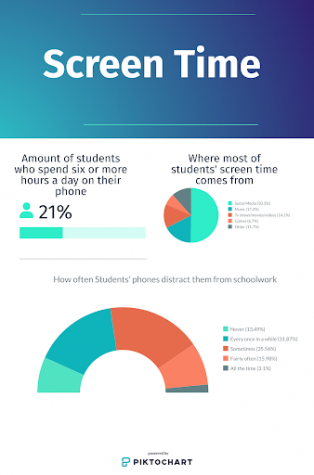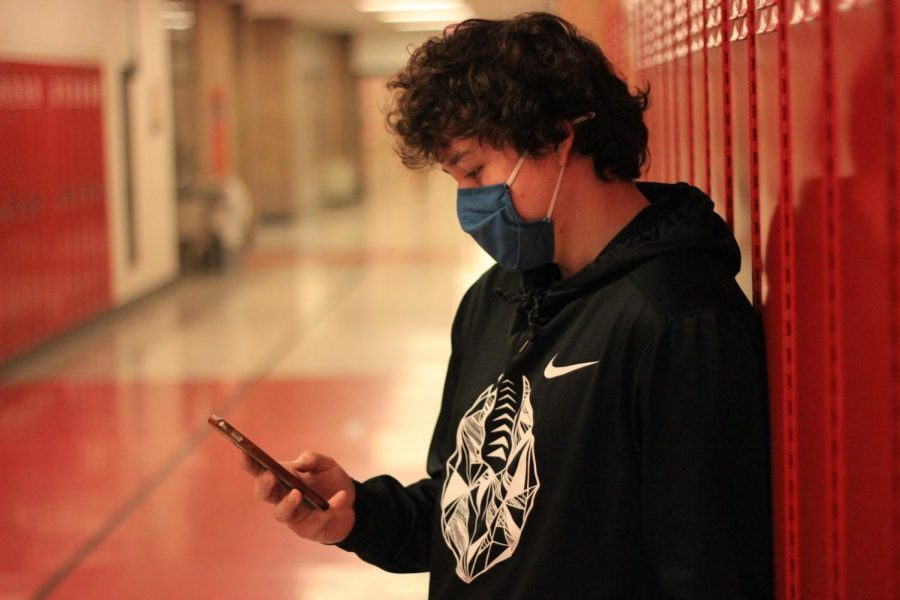Who’s controlling whom?
Usage of cell phones in the classroom
According to The Local Project, there are roughly 6 billion texts sent per day in the U.S. 50 percent of West students say most of their screen time on their phone is from social media.
April 14, 2021
According to ABC News, teens spend an average of seven hours and 22 minutes per day on their phones. That is over 50 hours every week. However, with so much knowledge and entertainment at our fingertips, it’s difficult to not spend over one-fourth of the day on our phones. So where’s the issue?
The issue is when phones negatively affect the students’ learning in the classroom; but recently, cell phones have been used for educational purposes as well. Aaron Cousins is a social studies teacher at West and has been teaching here since 2001. He has seen the evolution of phones being used in the classroom.
“I used to hate phones. You had to get them away, I didn’t want to see them; but now, we use the phones as an alternative to a chrome book. We try some interactive lessons with phones. It’s kind of like if you can’t beat them, join them kind of thing,” Cousins said.

There are times where using a phone in class is appropriate; however, most of the schoolwork can be done without a cell phone. Amanda Ray is a Language Arts teacher at West and has seen the excessive abuse of cell phones at school.
“Rarely [are phones used] for educational purposes, in my opinion. I don’t really have a problem even if they’re on their phone if they’re done with their work, but it’s definitely I think a huge distraction for schoolwork,” Ray said. “If I could legally prevent [kids from bringing their phones into the classroom] I would definitely say the [students] don’t need them, but sometimes it really is their parent texting them.”
Not every teacher agrees with Ray’s thoughts on banning phones in the classroom. Cousins understands that students need the break from schoolwork sometimes.
“I would like [phones not being allowed in the classroom] as a rule; but I think if we’re going to stick with the block, it’s a long amount of time and I can’t really hold [the students’ attentions] for 80 minutes, so I don’t know how you would enforce the rule. Now if we’re on like a traditional schedule, for 50 minutes, let’s get your phone away let’s crank this out and move on,” Cousins said.
“Oh I’ve asked […] and some of [the kids] have ten plus hours a day […] You’re at school for seven or eight hours, so I don’t know if they’re on it more at school [because] they’re busy outside of school, but yeah it’s crazy,” Ray said.
With 80 minute class periods, kids are bound to get distracted by their phones; however, students should not be on it an excessive amount. Dr. Nauman of OSF Healthcare stresses “limiting overall screen time to two hours a day, excluding homework.” Sadly, less than 16 percent of West students spend two hours or less on their phone per day. Senior Tate Kronfeld understands he has an excessive amount of screen time.
“In a day, probably 11 to 12 hours on [my phone]. I’m just addicted to my phone. [If I spent less time on my phone] my grades would definitely improve a lot because I’d be paying attention a lot more in class,” Kronfeld said.
Ultimately, the students are the only ones who can control their amount of screen time. Senior Rylee Rommel believes phones should be allowed in classrooms.
“I think that teachers shouldn’t control [the use of phones] too much. Obviously, if it’s something important going on then they can control it and say like ‘put it away’, but I think it’s really up to the kids. If they choose to be on their phone, that’s not really the teacher’s problem,” Rommel said.
“It’s a trade off right? You want to have your phone out, eventually you’re going to score lower,” Cousins said.
Teachers can sometimes have trouble preventing students from getting on their phones during class. It is difficult to force kids to stop using their phones in the classroom when there are not ample consequences to prevent kids doing it.
“I feel like there aren’t specific rules to handle [phone usage]. I know Mrs. Williams wants everyone to have their own policy that works for them in their classroom, but if it’s a thing and they keep getting on it then I can email their mom or whatever but then what? Like, if I write a referral what’s the next step?” Ray said.
Lackluster grades are one of the possible consequences for students being on their phones during class. Students are the only ones who can control their screen time and have to face the consequences of poor grades if they’re on it too much during inappropriate times.
There are students who are on their phones for two hours a day while there are others who are on it for 12 hours a day. It’s ultimately up to them on whether they want to prioritize their schoolwork or social life.







